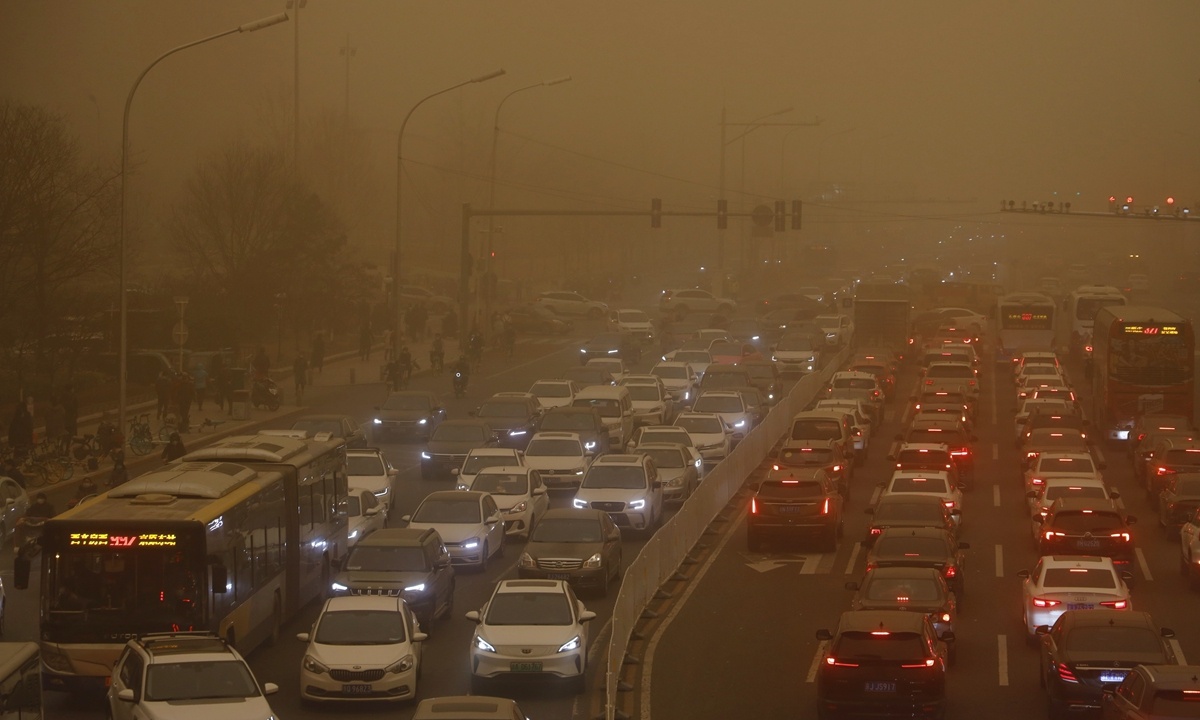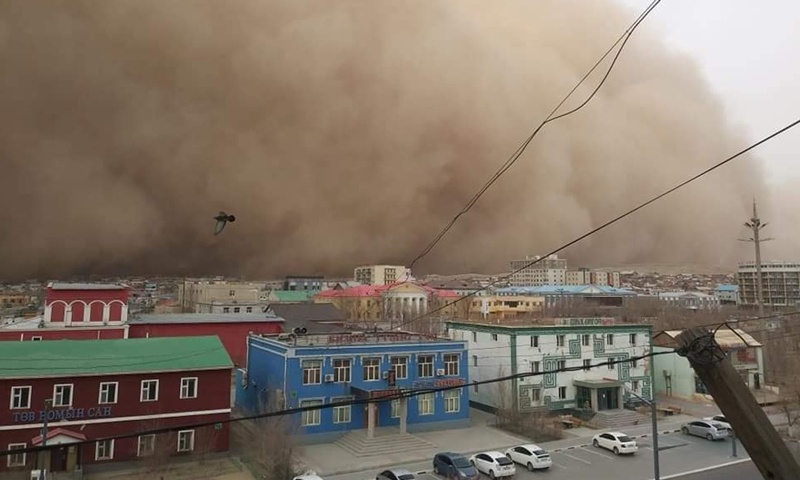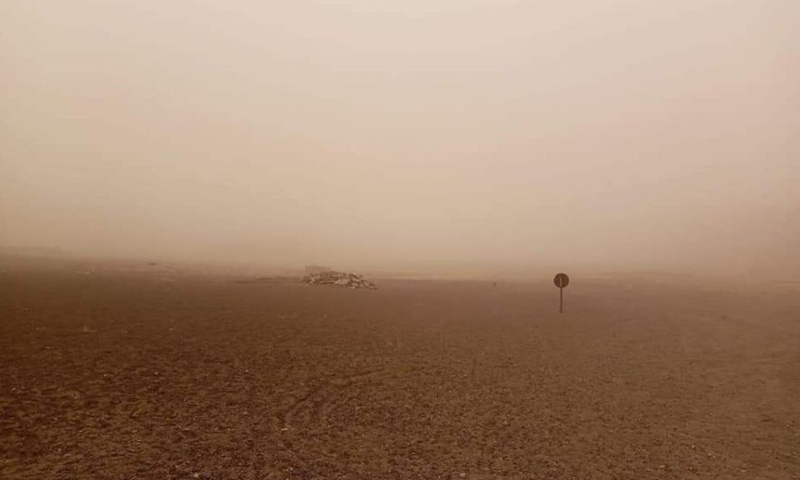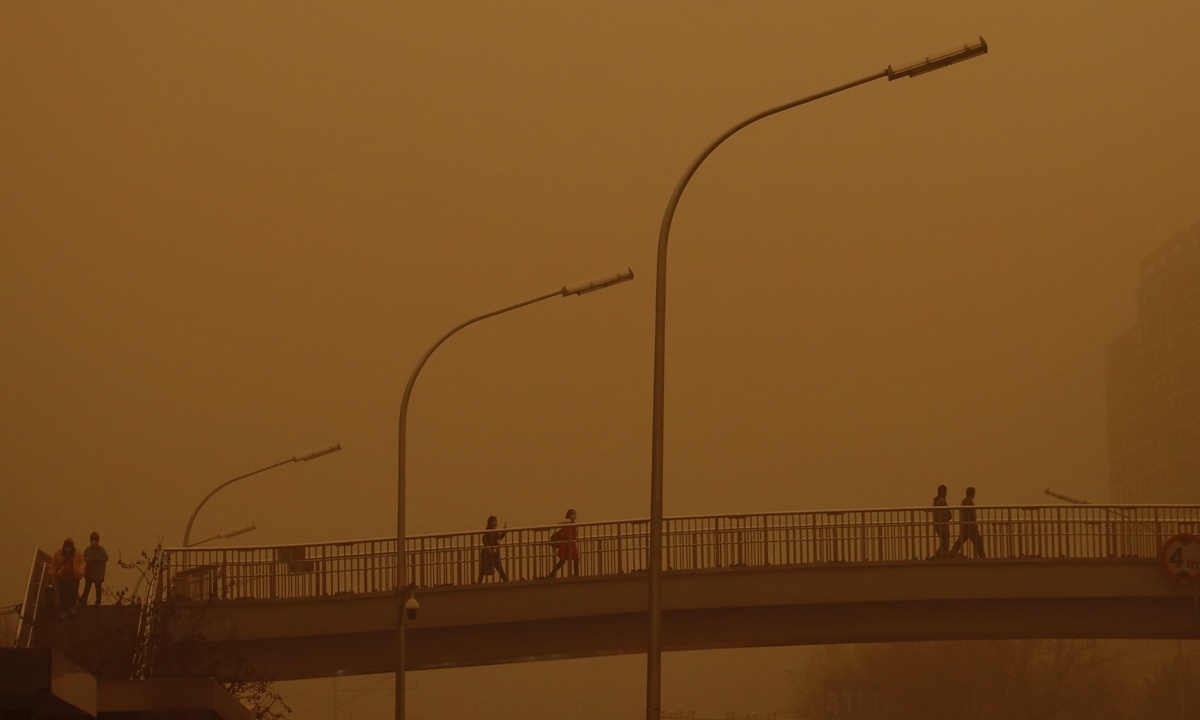
Beijing city issued a yellow alert for sandstorm as a severe sandstorm smothered the capital and other northern Chinese regions Monday morning. The meteorological agency called it the “the strongest sandstorm in the past decade" which has reached the level of a strong storm. (Photo:Global Times)
A powerful sandstorm originally from Mongolia has swept across much of northern China on Monday, creating the strongest and most extensive sandstorm in the country in a decade.
The strong sandstorm hit 12 provinces and cities in northern China from west to east as the sandstorm entered Chinese territory from the southwest part of its neighboring country Mongolia on Monday midnight with the moving airflow.
As this powerful sandstorm broke China's shelterbelt project sparked many to question why the shelterbelt did not work and why this wave of sandstorm has such a huge impact in China.
Chinese analysts said dust weather has been significantly and effectively reduced over the years as shelterbelt construction has been preventing dust drifting in a certain scale, but it lies on global cooperation to deal with desertification, in order to fundamentally solve its root cause.

Mongolia reported a strong snowstorm and sand dust weather over the weekend in multiple provinces. (Photo: Ministry of Environment and Tourism of Mongolia)
Originating from Mongolia
While powerful sandstorms have hit northern China, the neighboring country Mongolia had reported a strong snowstorm and sand dust weather over the weekend in multiple provinces.
The wind speeds had once reached 20 meters per second and there have been gusts of up to 30 to 34 meters per second, according to Mongolia's National Emergency Management Agency.
The neighboring country reported 10 deaths, including a five-year-old boy, and 590 reports of missing persons had been filed. As of 5:00 pm, 1 was still missing, the agency reported.
The weather damaged at least 58 yurts of residents, destroyed more than 120 households, and some 1,200 livestock were blown away, the agency said. Multiple routes of electric cables were cut off causing power outages in provinces such as Bayan-?lgii, Uvs and Khentii.

Mongolia reported a strong snowstorm and sand dust weather over the weekend in multiple provinces. (Photo: Montsame News Agency)
Ulaanbaatar, the capital city of Mongolia, was enveloped in thick sand. The dust storm in the capital lasted about three hours before cold air from the northwest moved the dust southward, the Global Times learned.
As the strong sandstorm came at a normal working day on Monday morning, causing trouble for many commuters, the topic quickly hit the top reading list on Chinese social media. Many said "sand seems to have fallen from the sky."
The visibility in most areas of Beijing was less than 1,000 meters and bringing the PM10 close to 10,000 micrograms per cubic meter in the city center.
The capital issued a yellow warning for sandstorms at 7:25 am, the Beijing Meteorological Observatory said Monday, warning the public to take suitable precautions. With a yellow warning, the public are encouraged to suspend any outdoor activities and to wear protective masks.

Beijing city issued a yellow alert for sandstorm as a severe sandstorm smothered the capital and other northern Chinese regions Monday morning. The meteorological agency called it the “the strongest sandstorm in the past decade" which has reached the level of a strong storm. (Photo:Global Times)
As of Monday noon, a total of 37 flights at two airports in Beijing were cancelled.
Kindergartens, elementary and secondary schools in Baotou and Manzhouli cities of North China's Inner Mongolia were closed Monday. Some city bus lines in Manzhouli were also temporarily suspended.
The Central Meteorological Observatory called the sandstorm on Monday the most intense sand-dust weather process in China in the past decade, and the range of sand dust storms was also the widest in the past 10 years.
The strong sand and dust was likely to continue during the day on Monday and see a downward trend late tonight.
South Korean media had forecasted that this yellow dust is expected to flow into South Korea through the north wind on Tuesday morning.
Global effort needed
It seems that the frequency of sandstorms has subsided in recent years, but what caused the strong sand dust weather on Monday and why did the shelterbelt that China set up in the northern part of the country fail to stop this wave of sandstorm from Mongolia?
Wang Gengchen, a research fellow at the Institute of Atmospheric Physics of the Chinese Academy of Sciences, told the Global Times on Monday that sand source, cyclone and flow movement are the three factors to form sandstorms. It is just the powerful cyclones that a large amount of dust in Mongolia was sucked into the high altitude, and pressured by cold anticyclone, the dust eventually transported to Chinese territory from Mongolia.

Beijing city issued a yellow alert for sandstorm as a severe sandstorm smothered the capital and other northern Chinese regions Monday morning. The meteorological agency called it the “the strongest sandstorm in the past decade" which has reached the level of a strong storm. (Photo: Global Times)
Shelterbelts have proven effective in reducing the frequency of sand and dust weather in Northern China over the past years, but it has a very limited effect on large-scale wind fields, and especially on strong weather processes like this, Wang noted.
Data by the Beijing Meteorological Bureau showed the latest sandstorms in Beijing occurred on April 15, 2015 and March 18, 2020. Since the 1980s, the average number of dust days in Beijing in March was 2.4, and the largest number of dust days since 2000 occurred in 2001 when recorded nine days of sandstorms in a year.
Shelterbelts will reduce the amount of dust within the shelterbelt area, preventing sand drifting, but it cannot stop desert and Gobi areas with forestation projects from having sand dust, which is the reason why shelterbelts did not stop this wave of sandstorm from Mongolia.
Shelterbelts play a role in reducing sand and dust weather, but cannot overcome sandstorms, experts said, which lies on the prevention and control of the sand source, experts said.

Beijing city issued a yellow alert for sandstorm as a severe sandstorm smothered the capital and other northern Chinese regions Monday morning. The meteorological agency called it the “the strongest sandstorm in the past decade" which has reached the level of a strong storm. (Photo:Global Times)
Due to global warming and excessive development, Mongolia's ecological problems have become increasingly prominent. Some 70 percent of the country's land is facing desertification in various degrees, and it is showing a trend of continuous expansion.
Grassland degradation in Mongolia was caused by multiple factors. Mongolia is a traditional animal husbandry country with more than 70 million livestock in 2020 and the disordered exploitation of mineral resources also accelerated the process of grassland desertification.
The Mongolian government has implemented more than 20 environmental protection plans but these have not achieved obvious results in terms of desertification control, the Global Times learned.
Research has shown about half of China's sandstorms come from dust in Mongolia, meaning the prevention and control of sand dust weather is a mission that cannot be achieved without global environment cooperation, Chen Guangting, a research fellow at the Cold and Arid Regions Environmental and Engineering Research Institute of the Chinese Academy of Sciences, told the Global Times.


